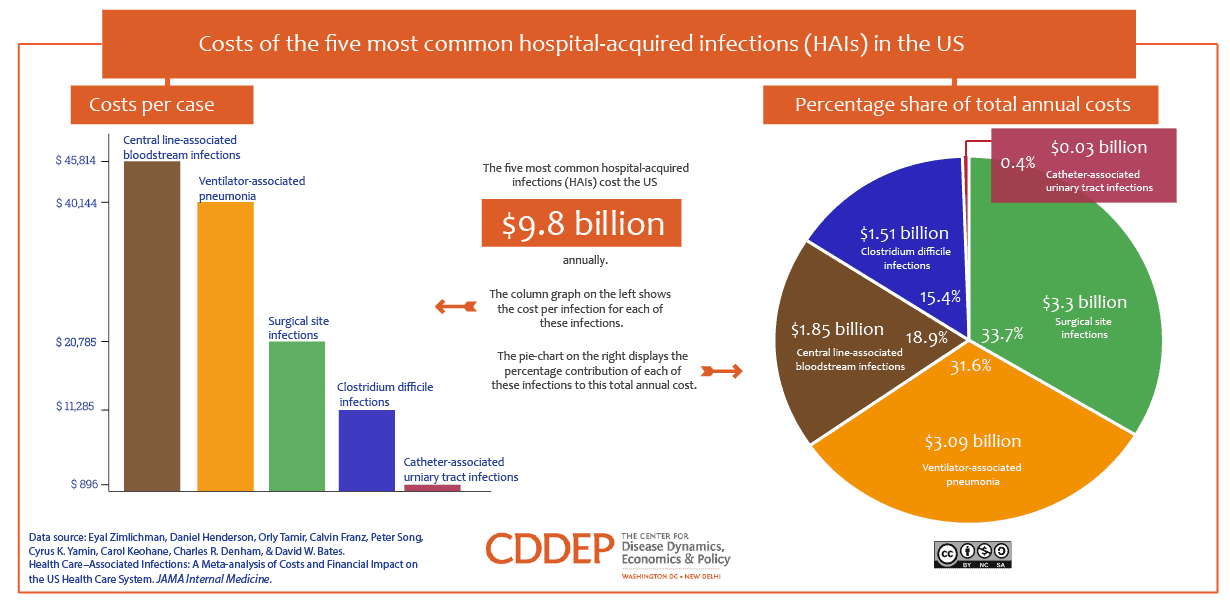This report describes national and state progress in preventing central line-associated bloodstream infections CLABSI catheter-associated urinary tract infections CAUTI select surgical site infections SSI hospital-onset C. The most well-known include those caused by methicillin-resistant Staphylococcus aureus MRSA and Clostridium difficile C.
Healthcare-associated infections acquired in intensive care units.

Most common healthcare associated infection. Health care-associated infections HCAIs are infections that occur while receiving health care developed in a hospital or other health care facility that first appear 48 hours or more after hospital admission or within 30 days after having received health care. Health care-associated infections HAIs are infections people get while theyre receiving health care for another condition. The Centers for Disease Control and Prevention CDC recommends avoiding use of the femoral vein in adults because of the higher infection rate.
HCAIs pose a serious risk to patients staff and visitors. 104236oalib1106222 PDF HTML XML 100 Downloads 310 Views Abstract. 50 percent decrease in central line-associated bloodstream infections CLABSI between 2008 and 2014.
MRSA stands for methicillin-resistant Staphylococcus aureus. Multiple studies indicate that the common types of adverse events affecting hospitalized patients are adverse drug events HCAIs. The acceptable challenges at ongoing comorbidities burdens at the.
Infections UTIs is not as high as with other health careassociated infections catheter-associated UTIs are the most common device-related health careassociated infection1. Most Common Health Care Associated Infections Aljaifi Saddam Hussein Mohammed 1 Sadik Yusuf Musse 2 1 School of Health Sciences Wuhan University Wuhan China. Most countries lack surveillance systems for HAI and those that do have them struggle with the complexity and the lack of.
Device-Associated Healthcare-Associated Infections DA-HAI including Ventilator-Associated Pneumonia VAP Central-Line-Associated Blood Stream Infection CLABSI and Catheter-Related Urinary Tract Infection CAUTI are considered as principal contributors to healthcare hazard and threat to patient safety as they can cause prolonged hospital stay sepsis and mortality in. These healthcare-associated infections HAIs include central line-associated bloodstream infections catheter-associated urinary tract infections and ventilator-associated pneumonia. Its a type of antibiotic-resistant bacteria.
The most well-known healthcare-associated infections for which mandatory reporting is currently required include those caused by meticillin-resistant. CDCs annual National and State Healthcare-Associated Infections Progress Report HAI Progress Report describes national and state progress in preventing HAIs. Norovirus is the most common tummy bug in Ireland.
Meticillin resistant staphylococcus aureus MRSA is a type of staphylococcus aureus that has become resistant to the antibiotic Meticillin and some other commonly used antibiotics. In the healthcare setting Klebsiella bacteria most often the pneumoniae species cause urinary tract infections wound infections upper respiratory tract infections osteomyelitis and even. You can find out more about HCAI including how they are caused and the most common types of infection on the Public Health England website.
Staphylococcus aureus MSSA Clostridium difficile C difficile and. Escherichia coli E coli. The following list ranks the most common healthcare-associated infections from highest prevalence to least.
HAIs are a significant cause of. Its known as the vomiting bug and spreads easily from. They can incur significant costs for the NHS and cause significant morbidity to those infected.
Infections may also occur at surgery sites known as surgical site infections. Although HAI is the most frequent adverse event in health care its true global burden remains unknown because of the difficulty in gathering reliable data. HAIs can happen in any health care facility including hospitals ambulatory surgical centers end-stage renal disease facilities and long-term care facilities.
Healthcare associated infections Norovirus. Among national acute care hospitals the most recent report 2014 data published 2016 found. In 2014 6 995 8 of patients staying in an intensive care unit ICU for more than two days presented with at least one ICU-acquired healthcare-associated infection.
CDC works to monitor and prevent these infections because they are an important threat to patient safety. Difficile infections and hospital-onset methicillin-resistant Staphylococcus aureus MRSA bacteremia bloodstream infections. These catheters are the type most commonly associated with central lineassociated bloodstream infections CLABSIs.
Bacteria fungi viruses or other less common pathogens can cause HAIs. 218 percent of all healthcare-associated infections 2. 2 School of Medicine Wuhan University Wuhan China.
Staphylococcus aureus MRSA meticillin-sensitive. Disease public health area.